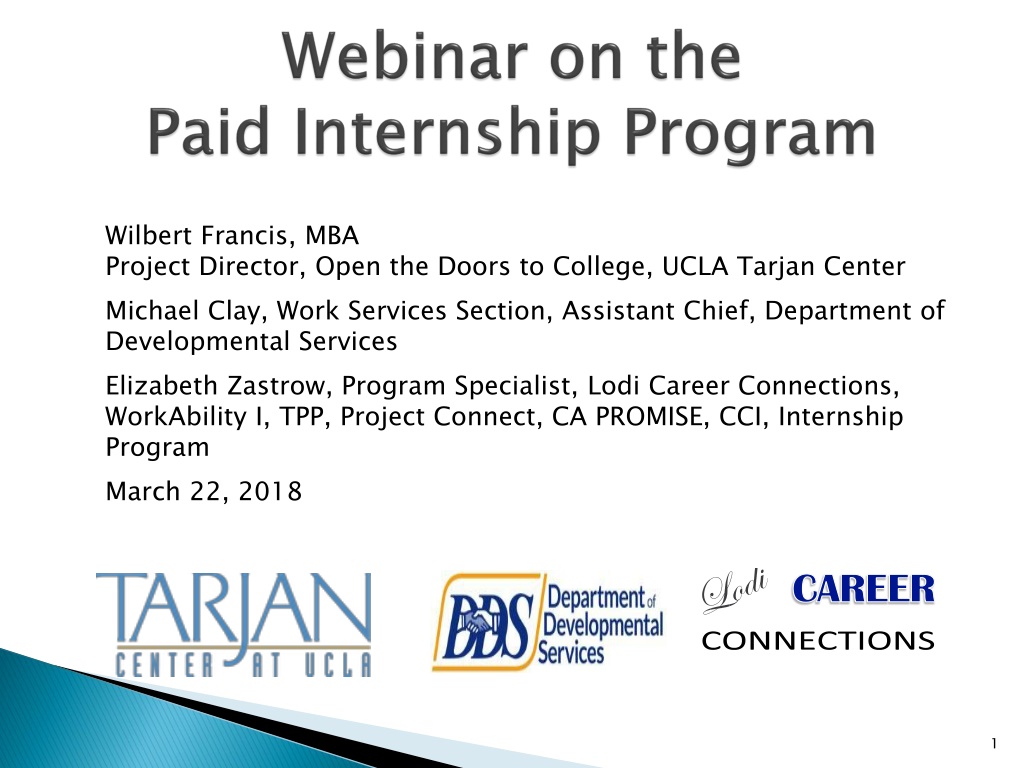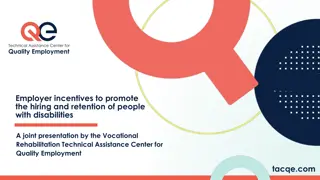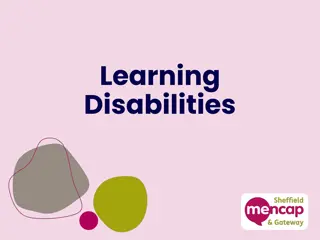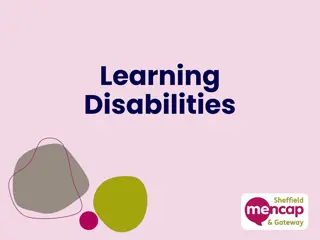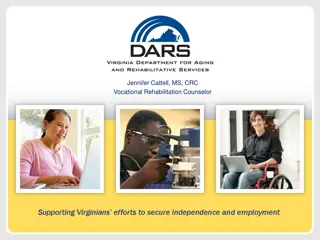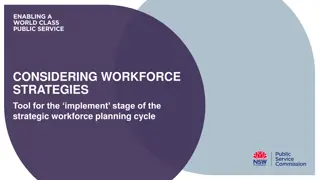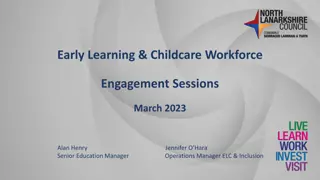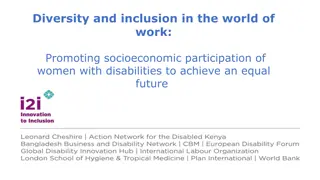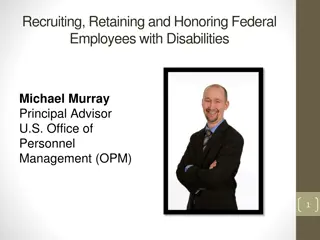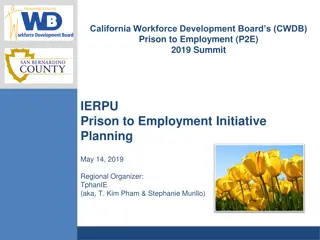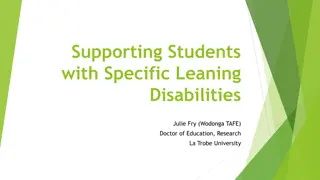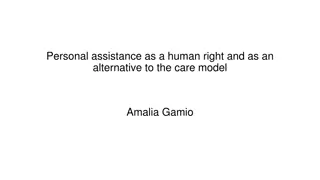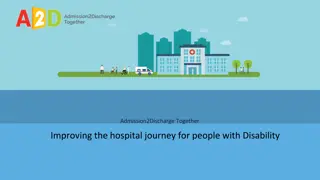Improving Opportunities for Individuals with Disabilities in California Workforce
Focused on enhancing collaboration and coordination among key departments to support individuals with intellectual and developmental disabilities in competitive integrated employment. Objectives include expanding information sharing, utilizing resources effectively, and increasing participation in the California workforce development system. Strategies aim to improve Triple E practices and support the transition from school to employment services.
Download Presentation

Please find below an Image/Link to download the presentation.
The content on the website is provided AS IS for your information and personal use only. It may not be sold, licensed, or shared on other websites without obtaining consent from the author. Download presentation by click this link. If you encounter any issues during the download, it is possible that the publisher has removed the file from their server.
E N D
Presentation Transcript
Wilbert Francis, MBA Project Director, Open the Doors to College, UCLA Tarjan Center Michael Clay, Work Services Section, Assistant Chief, Department of Developmental Services Elizabeth Zastrow, Program Specialist, Lodi Career Connections, WorkAbility I, TPP, Project Connect, CA PROMISE, CCI, Internship Program March 22, 2018 1
Employing Individuals with Intellectual Disabilities and Developmental Disabilities in California Real Work for Real Pay in the Real World Real Work for Real Pay in the Real World 2
Improve collaboration and coordination between the three departments to prepare and support all individuals with intellectual disabilities and developmental disabilities who choose competitive integrated employment. 3
Objectives Expand joint information sharing as permitted by law. Coordinate efforts to utilize existing resources effectively. Increase collaboration on planning, implementation, and evaluation of CIE. Strategies Jointly develop and communicate written guidance. Promote local level collaboration and development of LPAs that address CIE. Jointly improve data collection and sharing. 4
Increase opportunities for individuals with intellectual disabilities and developmental disabilities who choose CIE to prepare for and participate in the California workforce development system and achieve CIE within existing resources. 5
Objectives Increase CIE through participation in work experience, employment preparation services, soft skills training, PSE and training, customized employment, and supported employment individual placements. Increase participation of individuals with ID/DD in the California workforce development system, including America s Job Center of CaliforniaSM (one-stop). Improve business partner engagement and job- driven training with regard to hiring individuals with ID/DD in both the public and private sectors. 6
Strategies Jointly identify and improve Triple E practices. Determine and encourage statewide SE provider capacity to support CIE. Support transition from school to employment preparation services and CIE. Develop business partner initiatives. Develop tools and resources. 7
Support the ability of individuals with intellectual disabilities and developmental disabilities to make informed choices, adequately prepare for, transition to, and engage in CIE. 8
Objective Offer individuals, their support network, and business partners information and technical assistance related to CIE. Strategies Increase individual awareness of tools and resources available to support the achievement of their career goals toward CIE. Support the development of system knowledge, skill, and ability to deliver CIE. Increase participation in activities that support informed choice leading to CIE. 9
Provides $20 million dollars for the implementation of two programs designed to increase individuals opportunities in CIE: Paid Internship Program CIE Incentive Payments 10
The purpose of the program is to increase the vocational skills and abilities of consumers who choose to participate in an internship. Internship wages will be at least, state or local minimum wage. 11
Community Colleges, or their districts, can be vendorized by their area regional centers to provide internships. PIP funds, routed through the regional center, would provide the wages for the intern; however, the community college or its district, may need to provide the employment-related supports to the intern. 12
Examples of possible internships: Apartment Maintenance Media Production Glass Blowing and Artistry Child Care Bicycle Maintenance Dental Assistant Sales Associate 13
PIP funds can only be used for wage and payroll costs Plan to Achieve Self-Sufficiency (PASS) https://www.ssa.gov/disabilityresearch/wi/p ass.htm Impairment Related Work Expenses (IRWE) https://www.ssa.gov/ssi/spotlights/spot- work-expenses.htm 15
Incentive Payments for placing an individual in CIE placements, with an emphasis on the individual retaining the job. 1st payment of $1,000 = 30 days on job 2nd payment of $1,250 = 6 months on job 3rd payment of $1,500 = 12 months on job 16
An LPA documents the ways local partners will work together to streamline service delivery, engage their communities, and increase CIE opportunities for individuals with ID/DD. 1 7
Post-Secondary Education Activities As a pathway to employment, PSE activities, such as vocational training programs, community college programs, internships and adult education programs, assist individuals to prepare for the career of their choice. 18
LPAs A conversation with DOR, CDE and the Regional Center. Expand the LPA, to include other local entities, such as: Workforce Development Board; Community Colleges; America s Job Centers. The more involved local entities are to the process of communicating, cooperating and promoting CIE, the better the results will be. 19
Core partners Local educational agencies Department of Rehabilitation districts Regional centers Community partners Public community services Private non-profit services and organizations Community Colleges Employment services Business partners Core partners: Community partners 2 0
Linkages to statewide resources such as America s Job Center of California, Adult Education Programs, Community Colleges Disability Support Programs & Services (DSPS), Independent Living Centers (ILCs) and community college and adult education consortia to improve pathways to CIE. 2 1
Create frameworks to change the ways mutual customers of the core partners are served, to better utilize resources, and to produce improved employment outcomes. Create an opportunity for building trust, respect, and cooperation. 2 2
Collaborative person-centered planning processes and seamless delivery of services Career choices based on the individual s strengths, capabilities, preferences, lifestyle, cultural background, and informed choice Engagement and participation of underserved communities, including racially and ethnically diverse groups Trust, communication, and respect between organizations Increased CIE opportunities for individuals with ID/DD 2 3
Local Partnership Agreements may be developed at any time. CIE Blueprint commitments: By June 30, 2018, the departments have a goal to establish at least 13 new LPAs between LEAs, DOR districts, and regional centers. Over the next five years (2022) the goal is to have LPAs developed between DOR districts, regional centers, and 270 LEAs. 24
Contact your: local educational agency local DOR office local regional center Review the LPA Template Identify how your participation supports the intentions of the LPA Identify resources you can contribute 2 5
To view the Local Partnership Agreement Template please visit the California Health and Human Services Agency website at www.chhs.ca.gov and select the tab on the top right titled CIE . Please send questions and comments to CaliforniaCIE@dor.ca.gov 2 6
